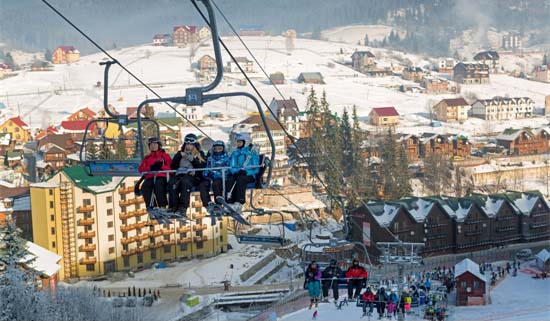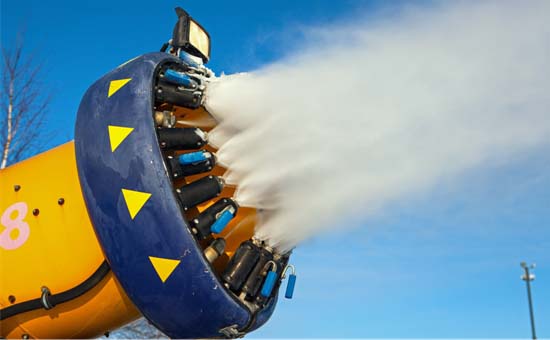Early Years of Ski Resorts
Ski resorts are located in mountainous regions that receive large amounts of snow and are developed for skiing and other winter sports. The earliest of the 37 ski resorts in the United States are Alta in Utah, and Sun Valley in Idaho, which opened in the 1930's. Chair lifts were installed not long after.
Not all establishments were full-service resorts when they opened for business. Monarch Mountain in Colorado opened commercially to skiers during the winter of 1936. After James Kane and Salida Winter Sports Club (SWSC) purchased a Chevy truck engine and moved it to Monarch Pass highway for a rope pull, access to the area got easier.
In 1939, SWSC applied to the US Forest Service for a permit to cut trails, construct lodges, and build a ski lift. Practically unbelievable today, season pass prices were just $1.00 with only 64 passes purchased. Rope tow revenue totaled $64.00. In 1946, Aspen Mountain featured a single seat chairlift that was considered the longest in the world.
Today, skiing, snowboarding and winter sports are among basic amenities at mountain resorts. New York has the most ski resorts of any state, topping the list at 50. Powder Mountain, located in Utah, has the largest ski area with 8,464 acres. Rope tows are still used on beginner hills and bunny slopes. However, chairlifts, gondolas, and aerial trams expand long distances up the mountain. Most ski areas have a basic patrol service, which is responsible for rule enforcement in the area.
Many resorts are completely or partially located on public lands. Each area pays a fee derived from income. The United States Department of Agriculture
(USDA) Forest Service is tasked with monitoring and enforcement. Visit
USDA Forest Service for more information.
Resort Lodging, Amenities and Services
There is more than one option for lodging offered by resorts. Some common options are:
- Hotels - Single rooms to suites offered with or without resort package additions.
- Time Shares - Condominium design that can consist of multiple bed and bathrooms. Contract purchase for a specified amount of time per year.
- Lodges - Prevalent on smaller complexes and house multiple guests with common areas
- Cabins - Often located in the more remote areas of the resort. Many have all of the comforts of a hotel or lodge, but can require a bit of travel to the main areas.
Large resorts are designed to completely accommodate the needs of visitors. Many provide shuttle services to local attractions, which are typically slopes and trails. Although, it is not uncommon for activities such as snowmobiling, sledding, horse-drawn sleds, ice-skating, snowcat rides, and tubing hills to be offered.
Many buildings are contained in the complex. Outfitting, grocery, liquor, sports gear, and apparel are examples of some common shops. Multiple dining options are offered to satisfy all tastes. Weddings, wedding party accommodations, and receptions can be part the specialized services. Many resorts offer winter sports lessons, and accommodate the level of any visitor. Often, weather determines the ease of travel in the mountains. The design goal of the resort is to allow the visitor to stay on their property for all of their vacation needs. Go to
Wikipedia List of Ski Areas and Resorts for resort links categorized by geographic location.
Slopes, Trails and Snow Production

The weather controls the start and length of a ski season. Geographic location and winters with large accumulations of snow increase the length of time slopes and trails are open. During seasons with normal or above normal accumulation, openings can be as soon as mid-October and closings can be as late as early June.
The moisture content in the area atmosphere does not always provide enough snow for resorts to maintain slopes and trails. Snow machines are used to produce artificial snow. The machine does not actually produce snow, but contributes moisture allowing the atmosphere to produce snow. High pressure water is routed through atomizers and distributed by electric fan motors. The fine particles of water freeze before hitting the ground.
Some resort owners maintain that the most advanced snow machines produce a quality of artificial snow that equals or exceeds characteristics of natural snow. Artificial snow is easier to maintain and lasts longer than natural snow. High pressure water supply and electricity are two of the main components. Both must be available in adequate supply for the machine to work correctly. Advanced snow blowers are digitally controlled and can be rotated to more than one position.
Snow blowing machines are self-contained units and are designed for transport with maintenance equipment. The snow production of the resort is on its own water and electricity grid. This grid is divided into stations for the location of the snow machine. Each station contains water and electrical connections. The utility grid allows the slope maintenance team to quickly change the location of the snow blowers. Some resorts report up to 150 stations to support snow production.
Portable Power and Emergency Backup Generators Provide Options
Resorts use a large amount of power. The infrastructure is much the same as any small town. An emergency source must be available in case of a utility power outage. Without backup power the resort is completely shut-down, causing financial and safety issues. Many snowmaking operations also utilize portable generators on the slopes at night and during the day while making snow, these are usually smaller mobile power generator sets like the one pictures to the right.
The National Fire Protection Agency (NFPA) Standard for Emergency and Standby Power Systems standard was adopted and introduced in 1985. Known as
NFPA 101 Life Safety Code. The code establishes:
- When emergency power is required
- Design requirements for emergency and standby power system
- Fire and safety systems that must maintain power during a utility outage
NFPA Standards provide minimum guidelines for backup generators. Emergency lighting, elevators, and fire protection systems are part of the systems that must have power in large facilities. Increasing the amount of emergency power on the grid allows for additional amenities and comforts, and enables the resort to remain open for business.
Generator Source is one of the world's largest generator suppliers. We have shipped numerous generators to a wide variety of ski areas and resorts throughout the US and Canada. We offer the option of new, surplus and low-hour, pre-owned generators. All generators must pass a 31-point inspection prior to being placed in the ready status. Our pre-owned and new generators are in stock and usually ship within 24-hours of order completion. Go to our
Inventory page to view generators in stock. We also provide a wide range of technical services including decommissioning, commissioning, installation, troubleshooting, and load testing.
Contact Us with any questions you have.
>>Back to Articles & Info<<